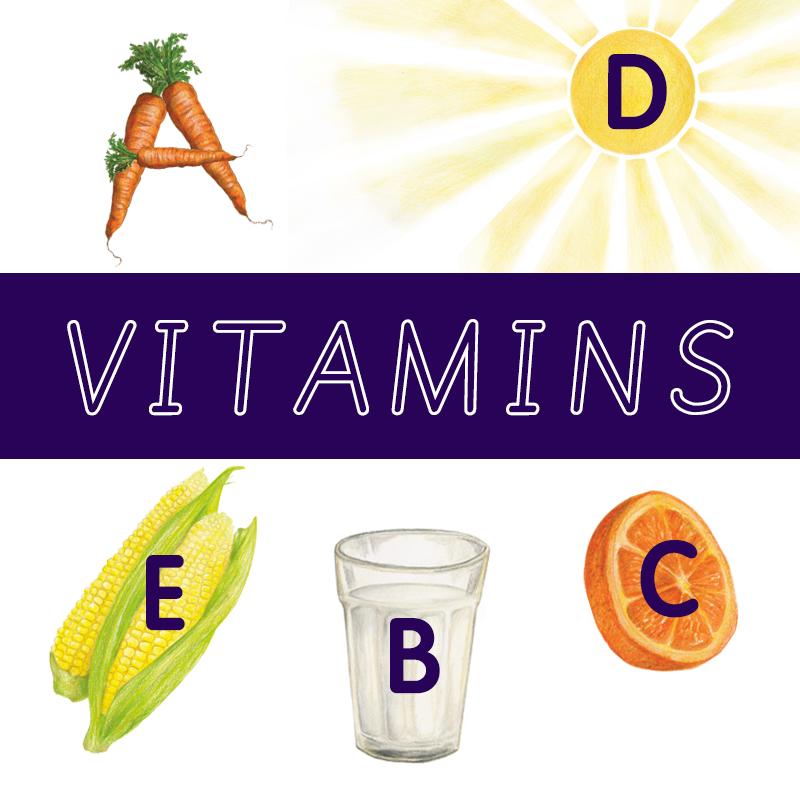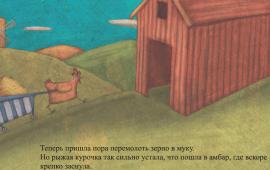From A to E – why the first five letters of the alphabet are so important when it comes to vitamins
Mantra Lingua’s great new bilingual title, Food, Food, Fabulous Food explores the foods we eat – come and discover for yourself.
Food – it’s one of the most important subjects in the world, and something that we can all relate to. And our amazing bodies convert it into energy to allow us to play, work, rest, recuperate and grow. Food is also essential as it’s packed with vitamins and minerals that, in most cases, our bodies cannot manufacture. Vitamins are also sometimes referred to as micronutrients, as they’re only required in small quantities each day – but if we’re lacking, or deficient, in vitamins, we’ll soon feel the effects.
Vitamin A
When I was young, my parents were always trying to get me to eat my carrots as “they would help me see in the dark”. I’m not entirely sure that’s actually the case for me, although vitamin A deficiency can lead to night blindness. This vitamin is essential for healthy eyes, skin, lungs and our digestive systems. You’ll find vitamin A in whole milk, cheese, butter, and liver. And you’ll also find plenty of vitamin A in those dark green leafy vegetables we’re always told are so good for us, as well as several orange-coloured fruits like apricots and mangos.
Vitamin B
Technically, vitamin B isn’t just one vitamin, it’s a whole family.
Vitamin B1, also known as thiamin, is one of the few vitamins that the body can synthesise for itself, but only in very small amounts. This vitamin is essential to keep our nervous system healthy, and to help us release energy from food. Good sources of vitamin B1 include fruit, fresh and dried; eggs; liver; peas; wholegrain breads; and some of the fortified breakfast cereals.
Vitamin B2, also known as riboflavin, is required for a healthy nervous system, healthy skin, and healthy eyes. Again, fortified breakfast cereals, eggs and milk are good sources of this vitamin, as is rice. These foods should, however, be kept out of direct sunlight as ultraviolet light can destroy riboflavin. The body can’t store this vitamin, so you need a small amount every day.
Vitamin B3, also called niacin, is also required for eye and skin health, and to help us access the energy in our food. Wheat flour, fish, meat, eggs and milk are all good food sources of this vitamin.
Vitamin B6, or pyridoxine, helps us process the energy in foods containing protein and carbohydrates, and also helps us form haemoglobin, the substance that carries oxygen around the body, and is found in red blood cells. This vitamin is present in poultry, like chicken or turkey; fish; wholegrain cereals, including some fortified breakfast cereals; and bread; pork; soya beans; peanuts; eggs and milk; and potatoes.
Vitamin B12 is also used in making red blood cells, releasing energy from food, keeping the nervous system healthy, and making use of folic acid. You’ll find B12 in cod, salmon; milk, cheese and eggs; meat; and some fortified breakfast cereals.
Folate, or the manufactured equivalent, folic acid, is another B vitamin needed for the creation and health of red blood cells. If you like the following foods, you should be getting plenty of folate: Brussels sprouts and broccoli, spinach and cabbage (yes, the dark green guys again); peas; chickpeas; fortified breakfast cereals; and liver (though expectant mums are advised not to eat liver).
There are other B vitamins, most of which we require in very small amounts.
Vitamin C
This vitamin is essential to make sure our skin, bones and cartilage (the connective tissue that links many parts of our body) stay healthy, and to protect our cells. It helps us heal if we cut or bruise ourselves, helps our blood vessels function, and also helps us absorb iron from non-animal sources. Fresh fruit and vegetables are packed with this vitamin: green vegetables (yes, there they are again); tomatoes, peppers, citrus fruits like oranges and grapefruit; berries; and potatoes, particularly new potatoes.
Vitamin D
There are two ways we can obtain vitamin D: either from sunlight, or from our food. Vitamin D is essential for healthy bones, and around the time of World War Two, rickets was a condition commonly seen in some areas due to the lack of vitamin D. Sadly, the condition is starting to be seen again. If you don’t live in an area that gets a lot of sun, then you have to obtain vitamin D from your food: eggs, fortified cereals, fat spreads, oily fish like mackerel, and meat. In recent years, some food manufacturers have started to add vitamin D to their products.
Vitamin E
We need vitamin E to help our bodies keep us safe from infection, as well as for healthy eyes. It’s found in plant and vegetable based oils, like olive oil, corn oil and soya, as well as in seeds and nuts. Cereal products are also high in vitamin E, particularly wheat germ.
Think about the foods you like to eat, and which ones are high in each vitamin, from A to E. Could you draw a picture of the foods concerned, or devise an ideal daily menu that would make sure you’re getting all the vitamins you need? While, in general, children need lower daily amounts of the vitamins than adults, we all need to make sure that we’re getting the right amount – and in some cases, not too much.
References
Vitamins (2009, revised February 2016), British Nutrition Foundation, https://www.nutrition.org.uk/nutritionscience/nutrients-food-and-ingredients/vitamins.html, (last accessed 17 April 2019)
Overview: Vitamins and minerals (2017), National Health Service, https://www.nhs.uk/conditions/vitamins-and-minerals (last accessed 17 April 2019)
Government Dietary Recommendations Government recommendations for energy and nutrients for males and females aged 1 – 18 years and 19+ years (2016), Public Health England, https://assets.publishing.service.gov.uk/government/uploads/system/uploads/attachment_data/file/618167/government_dietary_recommendations.pdf (last accessed 17 April 2019)
Food – it’s one of the most important subjects in the world, and something that we can all relate to. And our amazing bodies convert it into energy to allow us to play, work, rest, recuperate and grow. Food is also essential as it’s packed with vitamins and minerals that, in most cases, our bodies cannot manufacture. Vitamins are also sometimes referred to as micronutrients, as they’re only required in small quantities each day – but if we’re lacking, or deficient, in vitamins, we’ll soon feel the effects.
Vitamin A
When I was young, my parents were always trying to get me to eat my carrots as “they would help me see in the dark”. I’m not entirely sure that’s actually the case for me, although vitamin A deficiency can lead to night blindness. This vitamin is essential for healthy eyes, skin, lungs and our digestive systems. You’ll find vitamin A in whole milk, cheese, butter, and liver. And you’ll also find plenty of vitamin A in those dark green leafy vegetables we’re always told are so good for us, as well as several orange-coloured fruits like apricots and mangos.
Vitamin B
Technically, vitamin B isn’t just one vitamin, it’s a whole family.
Vitamin B1, also known as thiamin, is one of the few vitamins that the body can synthesise for itself, but only in very small amounts. This vitamin is essential to keep our nervous system healthy, and to help us release energy from food. Good sources of vitamin B1 include fruit, fresh and dried; eggs; liver; peas; wholegrain breads; and some of the fortified breakfast cereals.
Vitamin B2, also known as riboflavin, is required for a healthy nervous system, healthy skin, and healthy eyes. Again, fortified breakfast cereals, eggs and milk are good sources of this vitamin, as is rice. These foods should, however, be kept out of direct sunlight as ultraviolet light can destroy riboflavin. The body can’t store this vitamin, so you need a small amount every day.
Vitamin B3, also called niacin, is also required for eye and skin health, and to help us access the energy in our food. Wheat flour, fish, meat, eggs and milk are all good food sources of this vitamin.
Vitamin B6, or pyridoxine, helps us process the energy in foods containing protein and carbohydrates, and also helps us form haemoglobin, the substance that carries oxygen around the body, and is found in red blood cells. This vitamin is present in poultry, like chicken or turkey; fish; wholegrain cereals, including some fortified breakfast cereals; and bread; pork; soya beans; peanuts; eggs and milk; and potatoes.
Vitamin B12 is also used in making red blood cells, releasing energy from food, keeping the nervous system healthy, and making use of folic acid. You’ll find B12 in cod, salmon; milk, cheese and eggs; meat; and some fortified breakfast cereals.
Folate, or the manufactured equivalent, folic acid, is another B vitamin needed for the creation and health of red blood cells. If you like the following foods, you should be getting plenty of folate: Brussels sprouts and broccoli, spinach and cabbage (yes, the dark green guys again); peas; chickpeas; fortified breakfast cereals; and liver (though expectant mums are advised not to eat liver).
There are other B vitamins, most of which we require in very small amounts.
Vitamin C
This vitamin is essential to make sure our skin, bones and cartilage (the connective tissue that links many parts of our body) stay healthy, and to protect our cells. It helps us heal if we cut or bruise ourselves, helps our blood vessels function, and also helps us absorb iron from non-animal sources. Fresh fruit and vegetables are packed with this vitamin: green vegetables (yes, there they are again); tomatoes, peppers, citrus fruits like oranges and grapefruit; berries; and potatoes, particularly new potatoes.
Vitamin D
There are two ways we can obtain vitamin D: either from sunlight, or from our food. Vitamin D is essential for healthy bones, and around the time of World War Two, rickets was a condition commonly seen in some areas due to the lack of vitamin D. Sadly, the condition is starting to be seen again. If you don’t live in an area that gets a lot of sun, then you have to obtain vitamin D from your food: eggs, fortified cereals, fat spreads, oily fish like mackerel, and meat. In recent years, some food manufacturers have started to add vitamin D to their products.
Vitamin E
We need vitamin E to help our bodies keep us safe from infection, as well as for healthy eyes. It’s found in plant and vegetable based oils, like olive oil, corn oil and soya, as well as in seeds and nuts. Cereal products are also high in vitamin E, particularly wheat germ.
Think about the foods you like to eat, and which ones are high in each vitamin, from A to E. Could you draw a picture of the foods concerned, or devise an ideal daily menu that would make sure you’re getting all the vitamins you need? While, in general, children need lower daily amounts of the vitamins than adults, we all need to make sure that we’re getting the right amount – and in some cases, not too much.
References
Vitamins (2009, revised February 2016), British Nutrition Foundation, https://www.nutrition.org.uk/nutritionscience/nutrients-food-and-ingredients/vitamins.html, (last accessed 17 April 2019)
Overview: Vitamins and minerals (2017), National Health Service, https://www.nhs.uk/conditions/vitamins-and-minerals (last accessed 17 April 2019)
Government Dietary Recommendations Government recommendations for energy and nutrients for males and females aged 1 – 18 years and 19+ years (2016), Public Health England, https://assets.publishing.service.gov.uk/government/uploads/system/uploads/attachment_data/file/618167/government_dietary_recommendations.pdf (last accessed 17 April 2019)
Related Posts
-
Mind Your Language - A Note On the UN's International Literacy Day 2019
-
Bird Brains And Other Wildlife - The Next RSPB Birdwatch Is Heading Our Way...
-
9 Benefits of Reading to Children
-
And a very merry May Day to you too – some Mayday and Beltane celebrations and traditions
-
The Latest British Council report reveals struggle of language learners in the UK. Can bilingual books help?
-
Breaking The Ice On Your First Day At School
-
Not Everyone Celebrates New Year on 1 January....
-
Ramadan Begins!
-
A new kind of PENfriend – Mantra Lingua’s new digital device to help make sense of the world all around you
-
Do You Speak This Language? The Mantra Lingua L1 Key Terms & Letters Library













